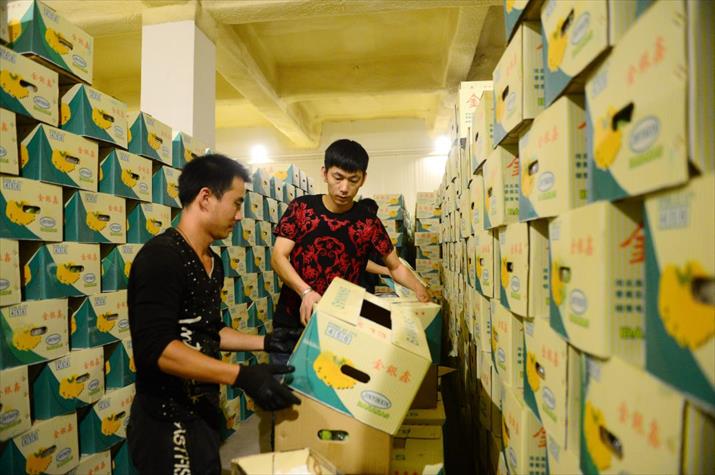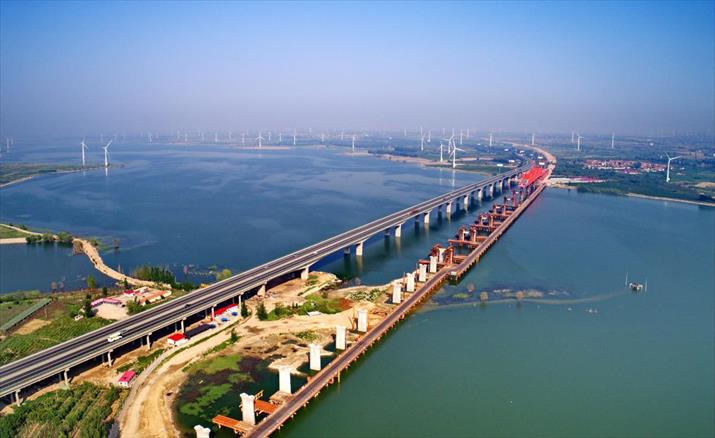|
||||||
|
||||||
| Home Nation World Business Opinion Lifestyle ChinAfrica Multimedia Columnists Documents Africa Travel |
|
||||||
|
||||||
| Home Nation World Business Opinion Lifestyle ChinAfrica Multimedia Columnists Documents Africa Travel |
| Nation |
| Integrated Vision |
| Coordinated development of the Beijing-Tianjin-Hebei region brings benefits and convenience |
| By Yuan Yuan | NO. 45 NOVEMBER 9, 2017 |
 Fan Jinsuo (right), a banana dealer in Xinfadi Agricultural Product Logistics Park in Gaobeidian, Hebei Province, works in his warehouse on September 8 (XINHUA)
Every morning, Feng Weili, a 35-year-old banana dealer in Xinfadi Agricultural Products Logistics Park in Gaobeidian, Hebei Province, needs to prepare more than 340 tons of fruit for vendors from neighboring regions. Covering an area of 138 hectares and with an investment of 5.4 billion yuan ($849 million), the market boasts 1.4 million square meters of cold storage and trading areas. It is projected to help reduce 5.6 million trucks travelling to Beijing every year and 300,000 wholesale employees in the city. Currently, 60 percent of bananas sold in Beijing are delivered from Gaobeidian Xinfadi. "We hesitated for quite a while in deciding whether to move here or not as this is a totally new location for us," Feng told Beijing Review. Before moving to Gaobeidian in 2015, Feng and her husband, Fan Jinsuo, did business in Beijing's Xinfadi Market. Located outside the Fourth Ring Road in south Beijing and home to about 5,000 businesses, Xinfadi was the largest agricultural wholesale market in the city with annual sales of 14 million tons of meat, fruit and vegetables. However, traffic congestion around the market and consequent problems meant it was among the first that Beijing planned to relocate in 2015 under a program to shift its non-essential functions to neighboring Tianjin and Hebei.  A bridge crossing Guanting Reservoir in Huailai County, Hebei Province. It is part of a high-speed railway connecting Beijing and Zhangjiakou in Hebei, the co-hosts of the 2022 Winter Olympic Games (XINHUA)
Beijing's role The Xinfadi market in Gaobeidian, located 84 km to the south of Beijing, was inaugurated in October 2015. The preferential policies available at Gaobeidian Xinfadi and the inevitability that Beijing would relocate the wholesale markets finally convinced many business people like Feng to make the move. "The warehouse we rent in Gaobeidian is three times the size of ours in Beijing and the rent is only 1.5 times higher," Feng said. Gaobeidian Xinfadi also offered free rent for the first year. "In Beijing, we could sell about 100 tons of bananas per day and here we can sell more than 300 tons." In 2016, Feng and her husband earned more than 1 million yuan ($151,000), which was three times as much as their average annual earnings in Beijing. They bought an apartment near the market in Gaobeidian. "We couldn't afford a house in Beijing," Feng said. "Now we live more comfortably and we are happy that we decided to move to Gaobeidian." "With the launch of the Xiongan New Area in April, we are now a supplier of agricultural products not only for Beijing, but for the new area," Wei Shujian, Executive Director of Hebei Xinfadi Group, the operator of Gaobeidian Xinfadi, said on October 23. Xiongan, spanning Xiongxian, Rongcheng and Anxin counties in Hebei that are close to Gaobeidian, will serve as a new home to Beijing's non-essential functions, according to its development plan. Since 2015, nine large agricultural wholesale markets in Beijing have been relocated to cities in Hebei to relieve Beijing's burden caused by an overcrowded population and heavy traffic congestion. The move is part of a strategy for coordinated development of the Beijing-Tianjin-Hebei region that was first proposed by President Xi Jinping in February 2014. In June 2015, the outline of a plan for the initiative was released, highlighting development-oriented solutions to ecological, social and economic problems, and incorporating environmental sustainability in development planning. On September 28, an overall development plan of Beijing in 2016-35, approved by the Central Committee of the Communist Party of China and the State Council, was released. It includes the coordinated development of the Beijing-Tianjin-Hebei region. "It is the first time that a plan for the coordinated development of the Beijing-Tianjin-Hebei region has been approved by central authorities," Shi Shusi, an economic commentator, told China Economic Net. "This will accelerate its implementation." Beijing will be the national center of political, cultural and international exchange activities, as well as a technological innovation center, according to the plan. "The fact that Beijing is not defined as an economic center can help structural adjustment in the city," Shi said. There are evident gaps in the level of development in Beijing, Tianjin and Hebei. Beijing, as the most developed area in north China, has long been burdened with "megacity syndrome," featuring overcrowding, heavy traffic and air pollution. The plan said Tianjin will be the national advanced research and development base for manufacturing and an international shipping key area in north China, as well as a demonstration area for financial innovation. Hebei will be an important trade and logistics base, an experimental area for industrial transformation and upgrading, a demonstration area for new urbanization, and the supporting area for ecological environment development for the whole region. The express link Li Mingzhe, a resident in Baoding, Hebei, commutes every workday between Baoding and Beijing. He gets up at 5 a.m. and sets off at 5:20 a.m. His whole journey from home to office, using high-speed train and then bus service, takes about two and a half hours. But for him, this is worthwhile as he can see his family every day. "My wife works in Baoding and we have a 3-year-old child at home," Li said. "I don't want to be apart from them." Li is one of many regular commuters doing the rounds in the Beijing-Tianjin-Hebei region. According to railway statistics, there are 646,000 passengers commuting between Beijing and Tianjin more than twice a month, and this number is steadily increasing with the issuance of a monthly pass for express trains. "We have a group on the social media app WeChat for frequent commuters between Tianjin and Beijing," said Xu Li, a Tianjin resident working in Beijing who commutes almost every workday. "In the past six months, its members increased from 30 to 50. The launch of the domestically developed Fuxing train has made the trip more comfortable with more leg room and Wi-Fi." Cities in Hebei are also hopping on the high-speed railway network. A trip from Beijing to many of them now takes no more than an hour. "It used to take more than two hours to go to Shijiazhuang, capital of Hebei, from Beijing," Li Xu, a businessman from Beijing, told Xinhua News Agency. "Now with the express train, it takes only one hour and eight minutes. It is very convenient for business trips and it is common to meet regular commuters on the train." Green energy The deepened integration is driving coordinated services in other aspects. At the end of September, more than 1,000 hospitals from Beijing, Tianjin and Hebei formed an alliance that provides real-time reimbursement for residents covered by the medical insurance in the three areas. "Previously, if a Hebei resident wanted to get medical treatment in Beijing, he had to pay the full bill before returning to his home city to be reimbursed," Lin Weimin, director of the medical insurance office of Yanda Hospital in Sanhe City, Hebei, told state broadcaster China Central Television. "Now, they can get reimbursement immediately after seeing a doctor in any hospital joining the alliance." In environmental management, the three areas have released uniform standards on pollutant control and launched a joint monitoring system. Coal, as the major fuel for heating in the north of China in winter, is also a leading source of air pollutants. Statistics from the Ministry of Environmental Protection show that the average coal consumption in the Beijing-Tianjin-Hebei region is about 400 million tons annually. Households that are not covered by central heating contribute more than 50 percent of the pollutants in winter. In August 2014, Beijing released a plan, requiring all households living in the six districts of the city center to switch to clean energy such as electricity or gas for heating. Tianjin and Hebei are coming on board with this plan. This winter, almost 200,000 households in Nancai Village, Wuqing District in Tianjin, will stop burning coal. More than 1.2 million households in Langfang and Baoding in Hebei will switch to clean energy sources. "There has also been progress in industrial upgrading and transfer within the Beijing-Tianjin-Hebei region," said He Lifeng, Minister of the National Development and Reform Commission, at a press conference on October 21. "There has been rapid progress in sectors including transportation, education and medical treatment." "Local governments have focused on environmental protection, and such efforts are expected to continue," He said. Copyedited by Francisco Little Comments to yuanyuan@bjreview.com |
|
||||||
About Us | Contact Us | Advertise with Us | Subscribe
|
||
| Copyright Beijing Review All rights reserved 京ICP备08005356号 京公网安备110102005860号 |